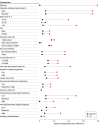Daily or Nondaily Vaping and Smoking Cessation Among Smokers
- PMID: 40042845
- PMCID: PMC11883493
- DOI: 10.1001/jamanetworkopen.2025.0089
Daily or Nondaily Vaping and Smoking Cessation Among Smokers
Abstract
Importance: An important public health goal is to increase tobacco cessation, but there is limited research on associations of vaping with tobacco cessation.
Objective: To estimate the association of vaping with long-term tobacco cessation among US cigarette smokers who used electronic nicotine delivery systems (ENDS; ie, e-cigarettes) in 2017.
Design, setting, and participants: This cohort study used a nationally representative sample of US cigarette smokers from the Population Assessment of Tobacco and Health cohort at wave 4 (2017) with follow-up at wave 6 (2021). Data were analyzed from June 2023 to June 2024.
Exposure: Wave 4 ENDS use: daily, nondaily, or no use.
Main outcomes and measures: The primary outcomes were 12 or more months' abstinence from cigarette smoking and 12 or more months' abstinence from both cigarette and ENDS use, ascertained at wave 6. Propensity score matching was used to control confounding on 14 potential confounders, including interest in quitting, income, age, education, nondaily smoking, and presence of a smoke-free home.
Results: A total of 6013 smokers were included in the sample (3634 aged ≥35 years [weighted percentage, 65.2%]; 3182 female [weighted percentage, 46.5%]). Among smokers who vaped daily (228 individuals), an estimated 20.9% (95% CI, 15.0% to 26.8%) were abstinent from cigarette smoking at follow-up, compared with 14.3% abstinence (95% CI, 13.0% to 15.5%) among smokers who did not vape (5070 individuals) and 12.6% abstinence (95% CI, 9.8% to 15.4%) among smokers who vaped nondaily (715 individuals). Compared with similar propensity score-matched smokers who did not vape, smoking cessation was 4.1 percentage points lower among those who vaped daily (95% CI, -11.9 to 3.6 percentage points; P = .30), a nonsignificant difference. Smoking cessation was 5.3 percentage points lower among those who vaped nondaily (95% CI, -9.1 to -1.5 percentage points; P = .01) compared with similar propensity score-matched controls. Considering abstinence from both smoking and vaping, compared with matched controls, smokers who vaped daily had lower abstinence at follow-up by 14.7 percentage points (95% CI, -20.2 to -9.2 percentage points; P < .001), and those who vaped nondaily had lower abstinence by 7.2 percentage points (95% CI, -10.7 to -3.8 percentage points; P < .001).
Conclusions and relevance: In this representative cohort study of US smokers who used ENDS, neither daily nor nondaily vaping was associated with increased smoking cessation, and each was associated with reduced tobacco abstinence, suggesting that careful adjustment of confounding is critical in studies of ENDS and smoking cessation.
Conflict of interest statement
Figures


References
-
- Centers for Disease Control and Prevention . E-cigarettes (vapes). Updated May 15, 2024. Accessed January 23, 2025. https://www.cdc.gov/tobacco/e-cigarettes/index.html#:~:text=Electronic%2...
-
- Gravely S, Yong HH, Reid JL, et al. . Do current smokers and ex-smokers who use nicotine vaping products daily versus weekly differ on their reasons for vaping? Findings from the 2020 ITC four country smoking and vaping survey. Int J Environ Res Public Health. 2022;19(21):14130. doi:10.3390/ijerph192114130 - DOI - PMC - PubMed

